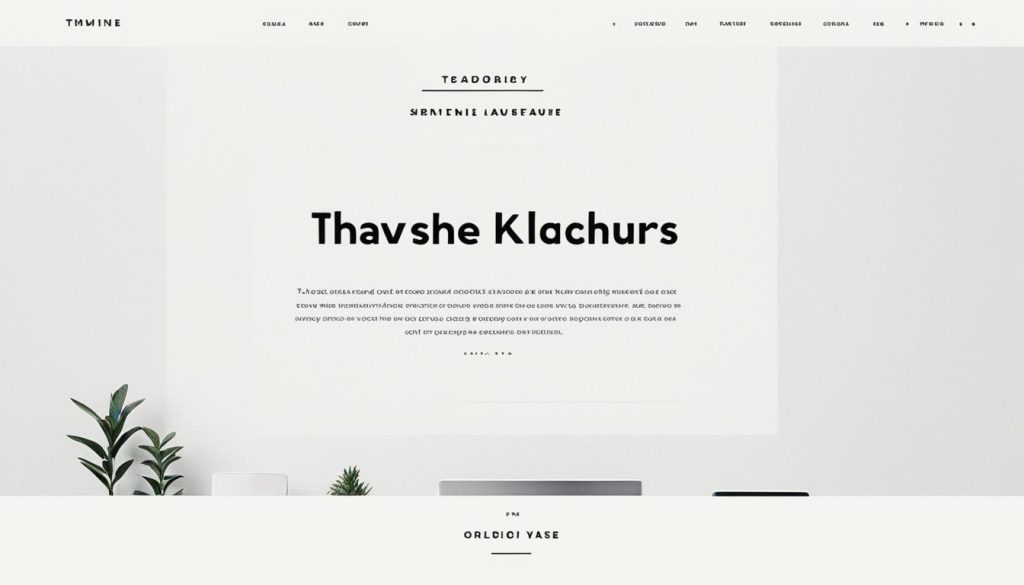How to make websites from scratch
Did you know that there are currently over 1.8 billion websites on the internet? With such a massive online presence, it’s no wonder that website development has become increasingly important. Whether you’re starting a business or simply want to have an online presence, knowing how to make websites from scratch is a valuable skill.
In this step-by-step web design tutorial, I will guide you through the process of website development, from honing your skills to testing and publishing your site. By the end of this guide, you’ll have the knowledge and confidence to create a website that reflects your brand and achieves your goals.
Key Takeaways:
- Building a website from scratch can be accomplished with the right preparation and guidance.
- Prerequisite web development skills include coding languages, troubleshooting, and knowledge of SEO.
- Establishing a clear goal and target audience is crucial for designing a tailored website.
- Selecting a hosting provider and domain name impacts site structure and usability.
- Choosing a site template or layout that aligns with your vision facilitates your intended user experience.
Hone Your Web Development Skills
Before you can start building a website, it is important to have some prerequisite web development skills. These skills include coding in languages like JavaScript and HTML/CSS, troubleshooting and debugging, and knowledge of search engine optimization (SEO). Additionally, having front and back end web development skills will allow you to have a comprehensive understanding of the technical aspects of a website. There are various online resources and courses available to help you learn these skills and become a proficient web developer.
Learning coding languages like JavaScript and HTML/CSS is essential for website development. JavaScript is a versatile programming language that adds interactivity and functionality to websites, while HTML/CSS is the foundation for structuring and designing web pages. Mastering these languages will enable you to create dynamic and visually appealing websites.
Troubleshooting and debugging skills are crucial for resolving any issues that may arise during the development process. As you build your website, it is inevitable that you will encounter technical challenges. Being able to identify and fix these problems will save you time and frustration.
Search engine optimization (SEO) is another crucial aspect of web development. It involves optimizing your website to rank higher in search engine results, ultimately driving more organic traffic. Understanding SEO best practices and implementing them into your website will improve its visibility and reach.
To enhance your web development skills further, it is recommended to have knowledge of both front-end and back-end development. Front-end development focuses on the visual and interactive elements of a website that users see and interact with, while back-end development involves server-side programming and database management. Having a solid understanding of both aspects will allow you to create fully functional and dynamic websites.
Whether you prefer self-paced learning or guided courses, there are numerous online resources available to help you hone your web development skills. Websites like Codecademy, Udemy, and Coursera offer comprehensive courses and tutorials on web development and coding languages. Taking advantage of these resources will equip you with the necessary skills to build professional and visually appealing websites.
Establish a Goal for Your Website
When creating a website, one of the first steps is to establish a clear goal. By determining the purpose of your website, you can design it to achieve specific objectives and cater to the needs of your target audience.
Start by identifying what you want to accomplish with your site. Are you looking to showcase your portfolio, sell products online, or provide information about your services? Defining your website goal is crucial as it will guide your design and content decisions.
Consider your target audience as well. Who are you trying to reach with your website? Understanding your audience’s preferences, demographics, and needs will help you create a user-centric experience. Tailoring your website to their expectations can lead to higher engagement, increased conversions, and improved satisfaction.
Furthermore, it’s essential to focus on user experience (UX). Providing a seamless and intuitive browsing experience will encourage visitors to stay on your site, explore its content, and take desired actions. Consider factors such as site navigation, page load speed, mobile responsiveness, and clear calls-to-action. These elements contribute to overall user satisfaction and can positively impact your website’s performance.
To determine the effectiveness of your website and its ability to achieve the established goal, track relevant metrics. Consider using tools like Google Analytics to monitor visitor behavior, conversion rates, and other key performance indicators (KPIs). These insights will help you identify areas for improvement and make data-driven decisions to optimize your site.
Overall, establishing a clear goal for your website allows you to strategically plan its layout, aesthetics, and content. By aligning your website’s purpose with the expectations of your target audience and focusing on user experience, you can create an impactful online presence that drives results.
| Benefits of Establishing a Clear Goal for Your Website: | Tips for Defining Your Website Goal: |
|---|---|
|
|
Choose a Hosting Provider and Domain Name
When it comes to building a website, selecting the right hosting provider and domain name is crucial. These decisions will impact your website’s structure, usability, and overall success. Consider the following factors to make an informed choice:
- Website Structure: Assess your website’s requirements and determine the hosting features and capabilities you need. Consider factors such as website size, traffic volume, storage space, and security features. Look for a hosting provider that offers scalable options to accommodate your future growth.
- Usability: Evaluate the user-friendliness of hosting platforms. Look for intuitive interfaces, easy-to-use control panels, and comprehensive customer support options. A user-friendly hosting provider will make it easier for you to manage and update your website as needed.
- Domain Name: Choose a domain name that is short, memorable, and reflects your brand or target audience. A well-chosen domain name can enhance your website’s discoverability and create a lasting impression on visitors.
Many hosting providers offer complimentary domain registration services and discounted website building tools for first-time users. Take advantage of these offerings to simplify your website creation process.

Remember, selecting a hosting provider and domain name is a crucial step in building a successful website. Take the time to research and choose wisely, ensuring that your website structure, usability, and overall user experience align with your goals.
Choose a Site Template or Layout
Your website’s layout is a crucial aspect that directly impacts the overall user experience. When selecting a website builder, it’s important to choose one that offers a wide range of site templates and layouts to suit your specific vision and requirements. Take into consideration the functionality you need for your website, such as e-commerce elements or appointment scheduling, and ensure that the chosen theme allows for customization.
Begin with a pre-designed template that aligns with your desired look and feel. These templates serve as a foundation that you can build upon, tailoring them to suit your branding and unique style. Customize the template by incorporating specific plugins, widgets, and color schemes that complement your content and enhance the functionality of your website.

By starting with a well-crafted template, you save time and effort in designing your website from scratch. Customization options allow you to personalize the template to create a website that reflects your brand identity and meets your specific functional requirements. Whether you need a clean and minimalist layout or a bold and vibrant design, there are numerous options available to bring your vision to life.
Consider the page hierarchy and organization that best suits your content and users’ navigation habits. A well-structured layout ensures that visitors can easily find the information they need and navigate through your website seamlessly. This includes designing intuitive menus, incorporating a logical flow between pages, and providing clear calls-to-action.
Additionally, prioritize mobile responsiveness when choosing a site template or layout. With an increasing number of users accessing websites through mobile devices, it’s crucial to ensure that your site provides a seamless and optimized experience across all screen sizes. Responsive design allows your website to adapt to different devices, enhancing user satisfaction and encouraging engagement.
Website Layout Tips:
- Choose a template that aligns with your branding and desired aesthetic
- Consider the functionality you need and ensure the template allows for customization
- Personalize the template by incorporating plugins, widgets, and color schemes
- Create a logical page hierarchy and intuitive navigation
- Prioritize mobile responsiveness for a seamless user experience across devices
| Advantages | Disadvantages |
|---|---|
| Time-saving: Starting with a template speeds up the website creation process | Potential for similarity: Templates may lack a unique or distinct look |
| Customization: Templates can be personalized to suit your brand and content | Limitations: Some templates may have restrictions on customization |
| Functionality: Templates often come pre-designed with useful features and plugins | Limited flexibility: Templates may not offer complete flexibility in design and functionality |
Build Relevant Pages
Most effective websites feature multiple pages or sections that are structured in a way that supports the user journey. As you build your site, consider the pages that are essential to achieving your goals. These may include a home page, about us page, product/service pages, blog, and contact page. Ensure that your site’s pages are organized in a logical and accessible manner, making it easy for users to navigate and find the information they need. Consider examples of successful websites in your industry to guide your page structure and content creation.
When building your website, one of the key considerations is the organization of your pages. Each page serves a specific purpose and contributes to the overall user experience. Here are some essential pages to include:
- Home Page: This is the first page users see when they visit your site. It should provide a clear overview of your brand, products, or services.
- About Us Page: Use this page to share information about your company, its history, mission, and values. This helps build trust and credibility with your audience.
- Product/Service Pages: If you offer specific products or services, create dedicated pages for each. Include detailed information, images, pricing, and any other relevant details.
- Blog: A blog is an excellent way to provide valuable content to your audience. It allows you to establish yourself as an expert in your industry and increase traffic to your site.
- Contact Page: Make it easy for users to get in touch with you by creating a dedicated contact page. Include a contact form, email address, phone number, and any other relevant contact information.
As you develop your site, keep in mind the user journey and the information your audience is looking for. Consider the logical flow of pages and how users will navigate through your site. A well-organized site structure enhances the overall user experience, increases engagement, and encourages conversions. Take inspiration from successful websites in your industry, but remember to tailor the structure to your specific goals and target audience.
Essential Website Pages
| Page | Purpose |
|---|---|
| Home | Provide an overview of your brand and offerings |
| About Us | Share information about your company and build trust |
| Product/Service | Showcase specific offerings and provide detailed information |
| Blog | Share valuable content and establish expertise |
| Contact | Make it easy for users to get in touch |
Establish a Payment System (If Applicable)
If your website aims to facilitate online shopping, it is crucial to establish a secure and user-friendly payment system. Creating a seamless online shopping experience for your customers not only fosters trust and loyalty but also increases the likelihood of completed transactions.
To ensure a smooth payment process, consider the payment methods you want to offer on your digital storefront. Popular options include credit/debit cards, digital wallet services like Google Pay and PayPal, and alternative payment methods like Apple Pay and cryptocurrencies.
When designing your storefront layout, prioritize simplicity and ease of use. Customers should be able to navigate through product offerings effortlessly, select their desired items, and proceed to the checkout process with minimal friction. A well-designed and intuitive checkout interface contributes to a positive user experience, minimizing cart abandonment rates and maximizing conversions.
Furthermore, it is essential to reassure your customers that their payment information is secure. Implementing robust security measures such as SSL encryption and PCI compliance ensures the protection of sensitive data, fostering trust and confidence in your online business. Highlight and display trust signals such as security badges and customer testimonials to further instill a sense of security in your customers’ minds.
Payment options at a glance:
| Payment Method | Benefits |
|---|---|
| Credit/Debit Cards | Widely accepted, convenient for customers |
| Digital Wallet Services (e.g., Google Pay, PayPal) | Quick and secure transactions |
| Alternative Payment Methods (e.g., Apple Pay, cryptocurrencies) | Appeals to specific customer preferences |
By establishing a reliable and user-friendly payment system, you can provide a seamless and secure online shopping experience for your customers, contributing to customer satisfaction, trust, and increased sales for your business.
Test and Fine-Tune Your Site
Now that you have built the key components of your website, it’s time to focus on testing and fine-tuning to ensure it delivers an optimal user experience. Pay close attention to the user interface (UI) and user experience (UX) by observing how visitors navigate your site and identifying any weaknesses or areas that need improvement.
Conducting comprehensive website testing is essential to identify and address any issues. Start by assessing site performance metrics, such as page loading speed, content optimization, and SEO factors. A fast and responsive website is crucial for retaining visitors and improving your search engine rankings.
In addition to technical performance, evaluate the usability and accessibility of your site. Check that your site is visually appealing, with a clean and intuitive interface that guides users effortlessly. Test navigation menus, forms, and links to ensure they function correctly and lead visitors to the right pages.
Furthermore, consider the overall user experience by putting yourself in the shoes of your target audience. Ask yourself if your website provides the information, features, and functionality that visitors are seeking. Continuously fine-tune your site based on feedback from real users, making improvements to enhance their experience and achieve your goals.
FAQ
What skills do I need to build a website from scratch?
How do I establish a goal for my website?
How do I choose a hosting provider and domain name?
How do I choose a site template or layout?
How do I build relevant pages for my website?
How do I establish a payment system for my online store?
How do I test and fine-tune my website?
- How Strategic SEO Drove Growth for a CPAP E-commerce Brand - July 24, 2025
- Top 3 SEO Companies in Toronto: An Analytical Comparison - July 23, 2025
- SEO for Entry Door Services - April 24, 2025





















Post Comment
You must be logged in to post a comment.